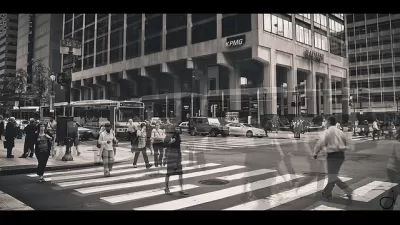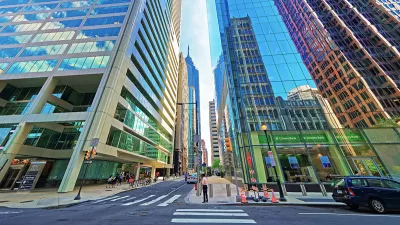Philadelphia Inquirer architecture critic Inga Saffron has the knives out for a new hotel built in Center City, calling it the 'worst new architecture' in the city. Worse yet, we all helped pay for such awful design.
"In the heated competition for the worst new architecture in Philadelphia, the sickly yellow, synthetic-covered mid-rise across from the Reading Terminal Market is now the one to beat," writes Saffron. "If the particular ugliness of the new Home2Suites at 12th and Arch Streets seems familiar, it is because this type of flimsy, style-challenged hotel is already a fixture at highway off-ramps across America."
"All this would be bad enough if the developers - Parkway and the Wurzak Hotel Group - had built the hotel entirely on their own dime," she adds. "But as often happens in Philadelphia, this $59 million plastic box was enabled by lavish subsidies from the city, state, and federal governments, including money allocated under the recent stimulus program."
"My beef isn't with the subsidies," she clarifies. "If government grants are necessary to kick-start economic development, fine. But just because you're subsidizing economic development doesn't mean you should be subsidizing poor design.
Writing in Next City, Bill Bradley takes issue with Saffron's "false dichotomy."
"Spurring economic growth and creating jobs is a good thing, but all that cash for what is essentially the Walmart of hotels doesn’t seem terribly fair to the rest of Center City. Where is that money for small local businesses? Or even, say, a boutique hotel like the Ace? Something that won’t deface the fabric of the city’s architecture."
"If anything," he writes, "subsidies should go toward fair economic development and good design."
FULL STORY: Changing Skyline: Cookie-cutter hotel cheapens Center City

Manufactured Crisis: Losing the Nation’s Largest Source of Unsubsidized Affordable Housing
Manufactured housing communities have long been an affordable housing option for millions of people living in the U.S., but that affordability is disappearing rapidly. How did we get here?

Americans May Be Stuck — But Why?
Americans are moving a lot less than they once did, and that is a problem. While Yoni Applebaum, in his highly-publicized article Stuck, gets the reasons badly wrong, it's still important to ask: why are we moving so much less than before?

Using Old Oil and Gas Wells for Green Energy Storage
Penn State researchers have found that repurposing abandoned oil and gas wells for geothermal-assisted compressed-air energy storage can boost efficiency, reduce environmental risks, and support clean energy and job transitions.

Poorest NYC Neighborhoods Pay Price for Delivery Boom
The rise of ‘last-mile’ e-commerce warehouses — and their attendant truck traffic and air pollution — is disproportionately impacting the most historically disadvantaged parts of the city.

Greening Oakland’s School Grounds
With help from community partners like the Trust for Public Land, Oakland Unified School District is turning barren, asphalt-covered schoolyards into vibrant, green spaces that support outdoor learning, play, and student well-being.

California Governor Suspends CEQA Reviews for Utilities in Fire Areas
Utility restoration efforts in areas affected by the January wildfires in Los Angeles will be exempt from environmental regulations to speed up the rebuilding of essential infrastructure.
Urban Design for Planners 1: Software Tools
This six-course series explores essential urban design concepts using open source software and equips planners with the tools they need to participate fully in the urban design process.
Planning for Universal Design
Learn the tools for implementing Universal Design in planning regulations.
Heyer Gruel & Associates PA
City of Moreno Valley
Institute for Housing and Urban Development Studies (IHS)
City of Grandview
Harvard GSD Executive Education
Salt Lake City
NYU Wagner Graduate School of Public Service
City of Cambridge, Maryland




























